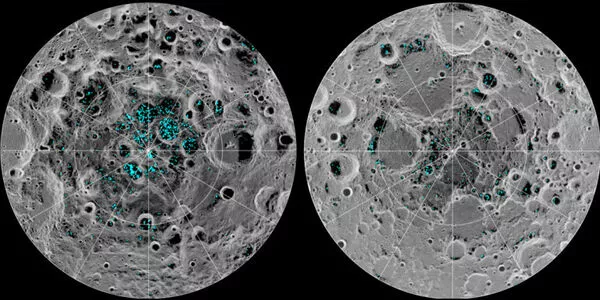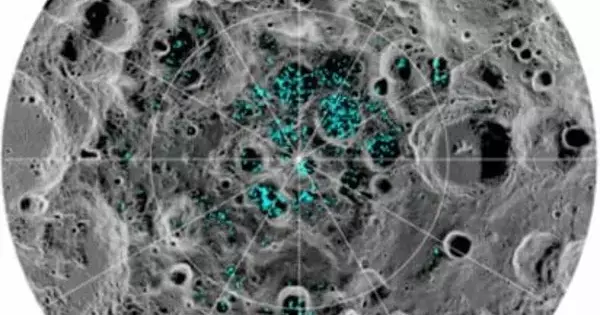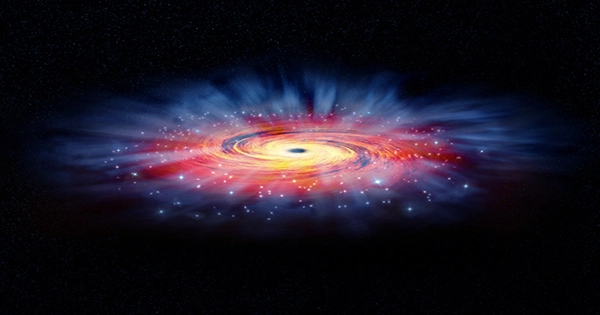According to new research from the University of Alaska Fairbanks Geophysical Institute, hydrogen and oxygen ions escaping from Earth’s upper atmosphere and combining on the moon could be one of the sources of known lunar water and ice.
Gunther Kletetschka, associate research professor at the UAF Geophysical Institute, led the research, which adds to a growing body of knowledge about water at the moon’s north and south poles. Finding water is critical to NASA’s Artemis project, which aims to establish a long-term human presence on the moon. NASA intends to return humans to the moon this decade.
“As NASA’s Artemis team plans to build a base camp on the moon’s south pole, the water ions that originated many eons ago on Earth can be used in the astronauts’ life support system,” Kletetschka said.
According to the new findings, the moon’s polar regions could contain up to 3,500 cubic kilometers (840 cubic miles) or more of surface permafrost or subsurface liquid water formed by ions that escaped Earth’s atmosphere. That’s the size of Lake Huron in North America, the world’s eighth-largest lake. The total was calculated using the lowest volume model calculation, with 1% of Earth’s atmospheric escape reaching the moon.
As NASA’s Artemis team plans to build a base camp on the moon’s south pole, the water ions that originated many eons ago on Earth can be used in the astronauts’ life support system.
Gunther Kletetschka
The majority of the lunar water is thought to have been deposited by asteroids and comets colliding with the moon. The majority occurred during a period known as the Late Heavy Bombardment. It is believed that around 3.5 billion years ago, when the solar system was about 1 billion years old, the early inner planets and Earth’s moon were subjected to unusually heavy asteroidal impact.
Scientists also speculate that the solar wind could be a source. The solar wind carries oxygen and hydrogen ions, which may have combined and deposited water molecules on the moon. There is now an additional explanation for how water accumulates on the moon.
The research was published in the journal Scientific Reports in a paper authored by Kletetschka and co-authored by Ph.D. student Nicholas Hasson of the Geophysical Institute and UAF Water and Environmental Research Center at the Institute for Northern Engineering. Several colleagues from the Czech Republic are also among the co-authors.

According to Kletetschka and his colleagues, hydrogen and oxygen ions are driven into the moon when it passes through the tail of the Earth’s magnetosphere, which occurs on five days of the moon’s monthly journey around the planet. The magnetosphere is a teardrop-shaped bubble formed by Earth’s magnetic field that protects the planet from a large portion of the continuous stream of charged solar particles.
Recent measurements from NASA, the European Space Agency, the Japan Aerospace Exploration Agency, and the Indian Space Research Organization revealed a high concentration of water-forming ions during the moon’s transit through this region of the magnetosphere.
These ions have slowly accumulated since the Late Heavy Bombardment.
The presence of the moon in the magnetosphere’s tail, known as the magnetotail, temporarily affects some of Earth’s magnetic field lines, which are broken and simply trail off into space for thousands of miles. Not all of Earth’s field lines are attached to the planet at both ends; some have only one. Consider each of these to be a thread tethered to a pole on a windy day.
The presence of the moon in the magnetotail causes some of these broken field lines to reconnect with their opposing broken counterpart. When this happens, hydrogen and oxygen ions that have escaped Earth rush to those reconnected field lines and are accelerated back toward Earth.
The paper’s authors suggest many of those returning ions hit the passing moon, which has no magnetosphere of its own to repel them. “It is like the moon is in the shower — a shower of water ions coming back to Earth, falling on the moon’s surface,” Kletetschka said.
The ions then bind together to form lunar permafrost. Some of it is driven below the surface by geologic and other processes, such as asteroid impacts, and can become liquid water.
The researchers studied polar regions as well as several major lunar craters using gravitational data from NASA’s Lunar Reconnaissance Orbiter. Anomalies in underground measurements at impact craters indicate the presence of fractured rock that could hold liquid water or ice. According to the research paper, gravity measurements at those subsurface locations indicate the presence of ice or liquid water.
















